Media | Articles
First-Gen Camaro (1967–69): The one that picked a fight
With the Camaro nameplate retiring soon, we’re honoring the beloved two-door with a series of love letters, fun lists, and memories over the next several weeks. You can follow along by clicking here.
Let’s not pretend the car we’re about to celebrate over the next week or so is perfect. In fact, the Camaro has always been flawed and beset with contradictions. It’s a sporty car, sometimes a very capable one, and yet many built over the decades had humble four- and six-cylinder engines and spent their lives as workaday commuters. It’s built by America’s largest automaker but is the consummate underdog, always playing catch-up with its crosstown rival, the Mustang, and scrapping for development dollars with its big brother, the Corvette.
The Camaro has, for most of its existence, lived in the crosshairs of the suits, who sent it into cold storage in 2002 and are doing so again at the end of this year. (Don’t think for a second, though, that it won’t be back.) To be even more blunt: The T-tops often leaked, the doors were usually too heavy, and the view out was almost always obstructed.
No matter, we love Camaros—have owned them, wrenched on them, and generally gotten up to no good in them. Judging by Hagerty data, you feel the same: It’s the fourth most popular car we insure. Our affection has a lot to do with all those “problems.” Many performance cars, especially nowadays, aim for an anodyne version of perfection that only a few can afford. The Camaro is for the rest of us—and it’s always ready to party. That in mind, let down your hair and come with us for a deep dive into what, exactly, makes the Camaro so bitchin’. We start at the beginning…
***
First Generation (1967–69)
The one that picked a fight
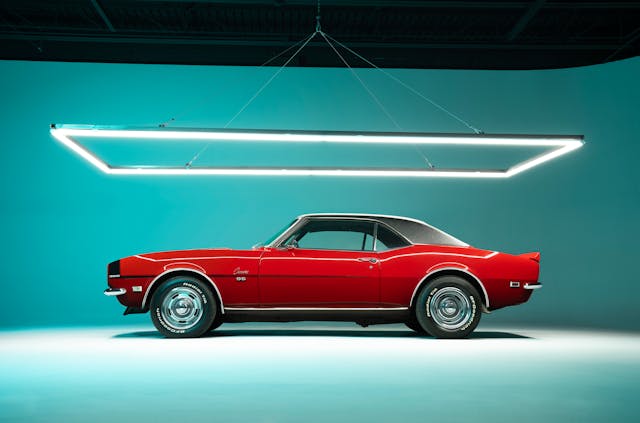
It was the worst kept secret in Detroit in the summer of 1966. Ever since the arrival of the spectacularly successful Ford Mustang two years earlier, all eyes had turned to Chevrolet and its expected counterattack. Word had gone around that the Bowtie’s answer, the so-called F-car, would be about the same size and price as the Mustang and that it would be christened the Panther. Ford even ginned up a mocking TV ad in which a feline panther unsuccessfully chased a Ford Mustang, and Ford PR reps would quip to any reporter who would listen that Chevy’s blatant knockoff should really be called the Parrot.
On Tuesday, June 28, 1966, newly promoted GM vice president and Chevrolet general manager Elliot Marantette “Pete” Estes made the official announcement from Detroit’s Statler-Hilton hotel over a coast-to-coast conference call with 200 reporters gathered in 14 cities. Backed up by a boisterous squad of Michigan State University cheerleaders, Estes triumphantly announced that Chevy’s new Mustang-beater, due in showrooms that September, would be called—well, uh, it sounded something like “ka-MAIR-oh.”

The Los Angeles Times reported that “a 30-member press gathering at the Beverly Hilton reacted to Estes’ announcement of the name with silence.” To the north, the San Francisco Examiner stated that journalists’ first reaction there was, “‘He must be kidding.’ The name sort of stirs the imagination as much as a wet noodle.”
Estes said that he settled on Camaro only that morning at 10 o’clock, because it both upheld Chevy’s C-centric naming convention—Corvair, Corvette, Chevelle, Chevy II—and in colloquial French loosely translates as “comrade,” (“…a word that also has its connotations,” said a smirking New Hampshire paper).
“We chose a name which, besides being lyrical and new, also reflects the purpose of the car. The real mission of the auto is to be a close companion of its owner, tailored to his or her individual tastes,” said Estes. Some observers also suggested that GM’s recent smackdown in the Ribicoff traffic-safety hearings that grew out of Ralph Nader’s 1965 book, Unsafe at Any Speed, and GM’s hiring of private investigators to discredit Nader had scared GM away from aggressive names that “subtly encourage speed by exciting images of power and violence,” according to one columnist at the time.

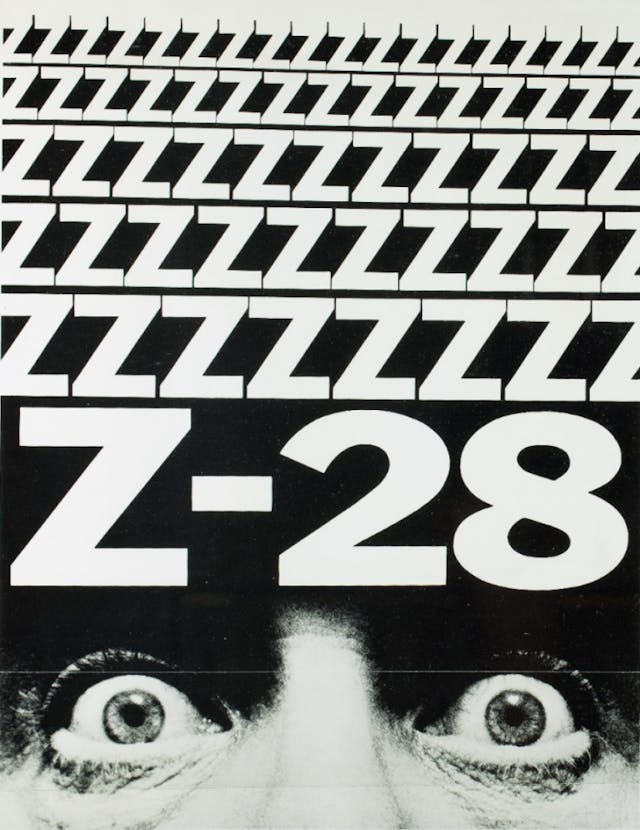
So, comrade Camaro it was, although bewildered French speakers said they had never heard the word before, and the entire English-speaking world had to be trained on how to pronounce it. “CA-maro,” and not “caMARo” or “camaRO.” Ford PR reps chortled—again, to anyone who would listen—that a Spanish word very much like it refers to a type of shrimp.
They had every reason for swagger. In just two years, Ford had pumped out more than a million Mustangs, saving the mid-1960s from being an otherwise dreary period for Detroit of repeated factory strikes, encroaching foreign competition, and soft sales. Additionally, the Mustang proved that there was a huge untapped market for what the industry called “specialty cars.” “When you have a winner, you have to expect competition,” mused Ford Division general manager Don Frey, who at the time lived across the street from Estes. “Imitation continues to be the sincerest form of flattery.”
Contrary to expectations that were elevated by the fiberglass-bodied Corvette and the rear-engine Corvair—as well as the front-drive ’66 Olds Toronado and the over-head-cam Pontiacs—there would be nothing very radical about the all-steel, rear-drive 1967 Camaro save for the hideaway headlights that disappeared behind motorized panels in the grille of RS editions. Chevy was aiming hard for a circa-$2400 base price, considered critical to effectively challenging the Mustang, and it would not be deterred by any of the techno-wizardry then pouring forth from GM R&D.

According to Chevy historian Michael Lamm, GM’s See-the-USA division committed to building a Mustang competitor as early as August 1964. It was a rush job on a shoestring, a sporty car to be grafted onto the bones of the Chevy II/Nova sedan (as was the Mustang an offspring of the Falcon). Bill Mitchell, who in 1958 succeeded Harley Earl as GM’s design chief, oversaw the styling of that first Camaro, code-named XP-836 and executed in Chevrolet Studio 2 at GM’s Technical Center in Warren, Michigan, where it was assigned to division stylist Henry Haga.
From the earliest clays, the Camaro’s shape departed from that of the straight-edged Mustang, brooming aside the midcentury-modern convention of flat fender lines and slab sides in favor of rounded haunches and a sloping nose and tail, pulling in elements of both the Corvette and Corvair. As with other sporty cars of the era, the ’67 Camaro’s front and rear fender lines swelled upward to peaks directly above the top of the wheel arches before tapering off. That little trick, called “Coke-bottle styling,” had made period designs from the Ford GT40 to the Lamborghini Miura to the ’68 Dodge Charger look good.
Although the Camaro’s 108.0-inch wheelbase was identical to the Mustang’s, its sedan underpinnings—including the high cowl and conservative dash-to-axle ratio—meant the first-gen Camaro would never be as long, low, or sexy as designers would have liked. Modern collectors might strenuously disagree with him, but Mitchell was a bigger fan of the second-gen 1970 Camaro, saying later that the ’67 was the hasty product of a committee.
Unlike the fully unitized Mustang, which had a frame welded to its body, GM engineers designed the Camaro around a semi-unitized concept, meaning everything forward of the firewall was supported by a bolt-on frame while everything aft of that was, as on the Mustang, integrated with the body. That engineering decision was unwittingly a gift to future restorers and customizers, who could easily swap out the Camaro’s front subframe for a new one or, in more recent years, an all-aluminum pro-touring setup.

Toying with many ideas, including a two-seat roadster and a two-door Nomad-style wagon, Chevrolet eventually settled on two straightforward body styles, a notchback coupe and a convertible, available with six-cylinder or V-8 and various trim levels. People had admired the look of fastbacks since they went mainstream in the late 1930s, but they almost universally plunked their money down on cars with protruding trunks. The 1966 Mustang notchback outsold the fastback by a rate of 14 to 1. The first Dodge Charger in 1966 was a daring fastback—and a colossal failure. The only real exception was the Barracuda, which Plymouth broadened in 1967 with a notchback to join the existing fastback and convertible. The Cuda fastback held its own, selling about the same as the notchback—though all of Barracuda’s sales in 1967 didn’t add up to two months’ worth of Mustang sales. Chevy was aiming higher, and it didn’t want the distraction of a fastback.
Ultimately, however, the first Camaro couldn’t beat Mustang in the showroom. Chevy’s two plants in Norwood, Ohio, and Van Nuys, California, churned out around 221,000 units in ’67, rising to 243,000 in 1969, when even a fading Mustang sold almost 300,000 units. But as the turbulent 1960s drew to a close, GM was undaunted; the Camaro and its sister car, the Firebird, were established enough in three short years to be worthy of a complete reinvention for the next decade.
***
Marketplace
Buy and sell classics with confidence
Check out the Hagerty Media homepage so you don’t miss a single story, or better yet, bookmark it. To get our best stories delivered right to your inbox, subscribe to our newsletters.
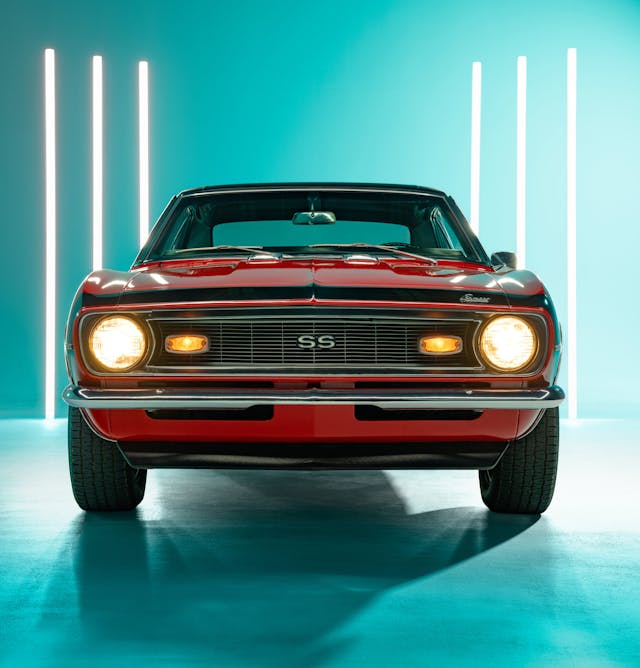
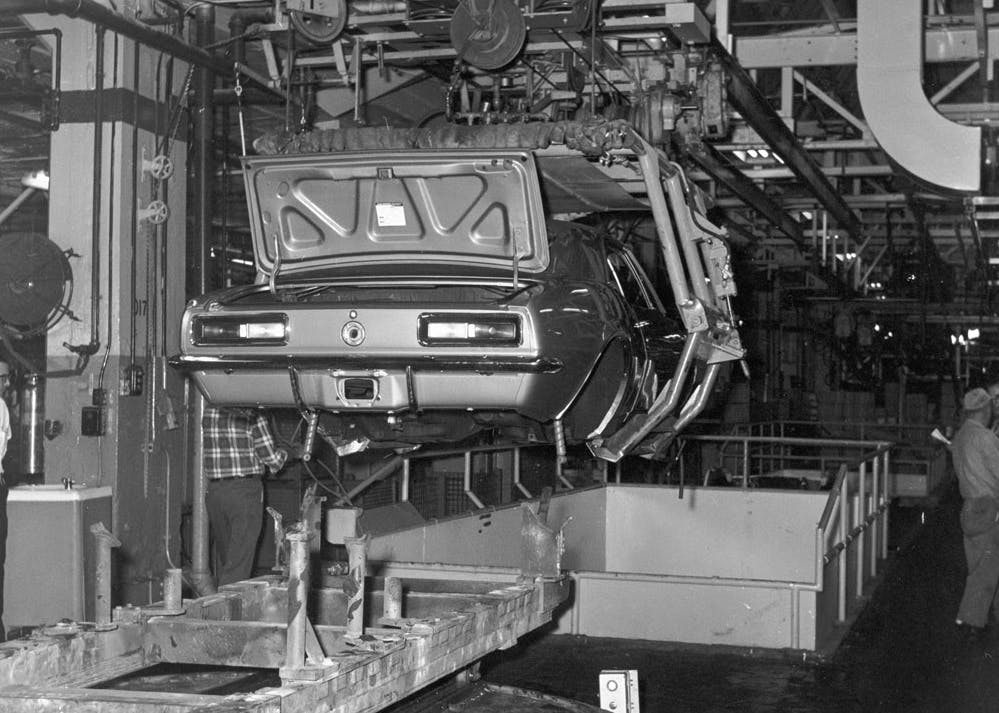
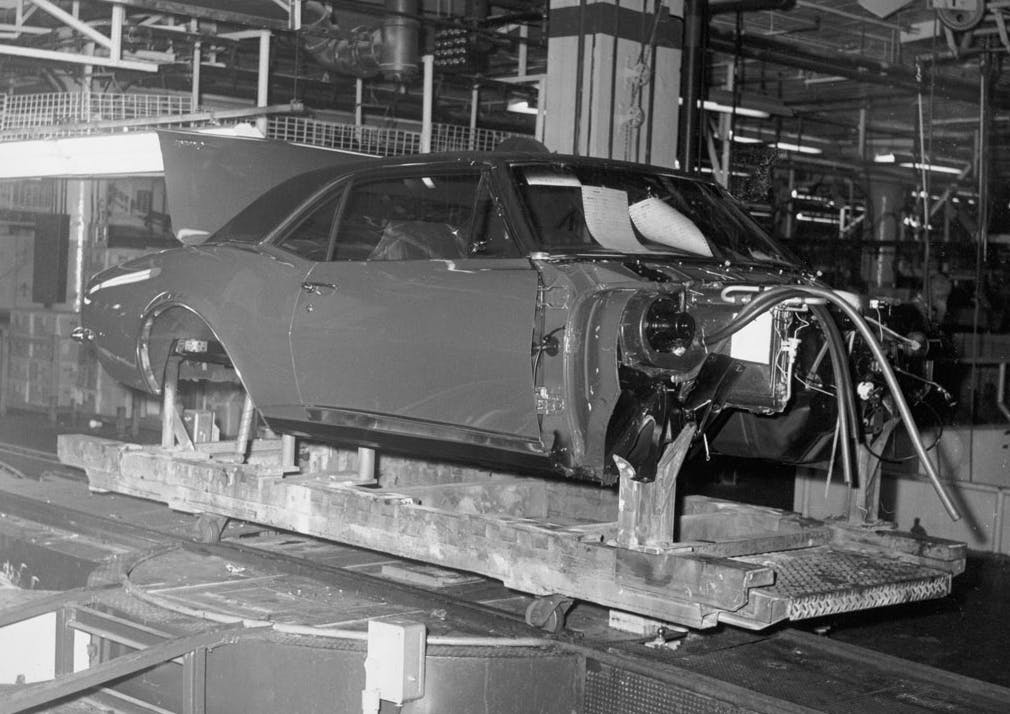












This story was written by someone who appears to favor the Mustang over the Camaro.
Each car had their own in different years. The Mustang was first out of the gate but the Camaro was the better car once to market. The entire performance industry was started on the Small Block in the 50’s and then built on the Camaro in the 60’s and 70’s,
The Camaro was the better built car and had much more that you could do to it as the aftermarket was extensive. Ford never saw that till the 5.0 came along in the mid 80’s.
Sure there were the Shelby cars that were built by Shelby but then they became just decal cars built by Ford.
Neither car was ever perfect as in the price class they were in most of their lives it limited them to a price point but in the Camaro’s case the aftermarket offered what Chevy may not have.
Even better the Firebird back when Pontiac was still a Pontiac you could get different engines and suspension that did not come with the Chevy.
In the later years both cars matured as the market changed and the buyers got older. Both are very good GT coupes today but the segment is dying the number of Camaro and Mustangs combined being sold are not even 1/4 what one sold before.
It is sad but the formula changed. These cars were build on cheap econo chassis but today there is no longer a cheap econo REW chassis to build on. This drove up cost and down sales. Coupe are not popular in any class anymore and only high priced low volume cars can survive.
What is really sad is many today feel that you can not drive RWD in the snow. The truth is we did for nearly a century. Today with the electronics it still can easily be done with non summer tires. Now as for people having the skill to drive may not be in play.
The early Mustang out sold the Camaro but one has to keep in mind most of these Mustangs were low priced In line 6 cars where most of the Camaro models were higher priced V8 models. GM may have kost the sale battle but they did win the profits war.
What was more interesting was what Delorean had planned for the Firebird and never got to do He wanted a two seat sports car built on this platform. He ended up with little time to finish his car so he built a better and one inch lower car with the Pontiac engine and better handling. He also added a OHV I6.
The one sin GM did in this era was not let the F body be all it could have been.
“The early Mustang out sold the Camaro but one has to keep in mind most of these Mustangs were low priced In line 6 cars where most of the Camaro models were higher priced V8 models. GM may have kost the sale battle but they did win the profits war.”
Don’t fool yourself, there were plenty of in-line 6 Camaros built too.
True – but I feel that, over the decades, I saw a lot more 1960’s 6-cylinder Mustangs than Camaros. I cannot prove that, but I believe it to be true. I think that, in the 1960’s, the Venn diagrams of characteristics and wants of Mustang and Camaro buyers had a lot of overlap, but were not 100% the same.
“True – but I feel that, over the decades, I saw a lot more 1960’s 6-cylinder Mustangs than Camaros. I cannot prove that, but I believe it to be true.”
That’s because Ford sold more Mustangs than Chevy sold Camaros. Numbers are hard to get but here’s what I could find:
Mustang:
1965 L6 = 198,900 (36%)
1965 V8 = 360,600 (64%)
1966 L6 = 253,200 (42%)
1966 V8 = 354,400 (58%)
1967 L6 = 141,500 (30%)
1967 V8 = 330,600 (70%)
Camaro:
1967 L6 = 58,808 (27%)
1967 V8 = 162,098 (73%)
1968 L6 = 50,969 (22%)
1968 V8 = 184,178 (78%)
1969 L6 = 36,248 (15%)
1969 V8 = 206,837 (85%)
1967 was the only year I could find data for both. There were 141,500 6-cylinder Mustangs sold to just 58,808 6-cylinder Camaros sold. So, yeah, you saw way more 6-cylinder Mustangs but if you look at the percentage breakdown, 30% of Mustangs sold were 6 cylinders while 27% of Camaros sold were 6 cylinders. So, 3% isn’t that much. And Ford sold almost as many 6-cylinder Mustangs as Chevy sold V8 Camaros.
It is true that RWD can be driven in the snow (and I did it almost exclusively for my first two decades of driving), but the laws of physics will not be denied – even with modern traction control and winter tires. A FWD vehicle with winter tires and TC will be better in the great majority of driving situations, than the same equipment on a front-engined RWD vehicle.
FWD is only superior to RWD in slow, slippery moving conditions, and only slightly to none at all on an incline.
Anyone notice the broken headlight door on the (brand new?!) one on the transport truck?
Just a vacuum leak likely. They were known to not open or close as needed.
That is they the clear strips were added in 1969. The headlamps could still shine through.
How do you know they are new and not demos or test cars.
I will readily admit up front that I was a Chevy guy clear back in the ’50s, so maybe my bias was showing, but when the Camaro came out I was instantly over ANY interest in Mustangs (what little there was). Prettier cars, hands-down. Better performing cars, arguably. I had a friend who got a brand-new ’69 RS/SS and that thing consumed so many Mustangs that you’d think it was fueled by horsemeat instead of gasoline.
I was among the many fans who lamented when the Camaro went away the first time, and although the rebirth was not as exciting as the Genisus, it certainly was nice to welcome the old pony car back to the streets. I’ll trust the author is right – that it’ll be back someday for yet a third iteration. Hope I’m around to see it.
OK, maybe i misread this but, “CA-maro,” and not “caMARo” or “camaRO.” ??
So we emphasize the FIRST syllable, as in CAmera?
I’ve NEVER heard that pronunciation, ever.
’69 is the best looking Camaro by far. As far as being better cars than the Mustang & being able to do more with them, I’d question that. At the time, we were still in the era of very little aftermarket equipment for Ford products & still under the thought process of ” Ain’t nothin’ better than a Chevy”.
And to my eyes the ’69 Firebird was the best looking one, as I had a couple of them over the years….the OHC6 Sprint was my favorite.
What I found disappointing was how cheap the first mustangs were built.
Remove the gas tank and there is no trunk floor. Also not very safe.
Any present owners have retrofitted better fuel cells.
The Camaro had a real floor in the trunk and the gas tank is just a tank not a floor.
Sorry to disagree with the self-imposed, know-it-all … but many Fords (and Mopars) have fuel tanks that were the trunk floor. It’s just the way cars were designed and built back then. It’s no less safe than Chevy trucks having the fuel tank behind the seat in the cab of the truck.
And like a lot of Ford pickups had also.
The 1st gen Camaros seem to be very popular in my area. Maybe as popular as their contemporary Mustangs.
I want to go back in time and hijack that transport truck.
No mention of the fastback
’65 Marlin, similar to the ’66 Charger, but a minute drop in the bucket sales-wise compared to the Mustang. Or Camaro. It’s wasn’t until the ’68 Javelin that AMC got it right. ’65-6 Mustang fastbacks are the rage now; I always thought they looked odd, the roof tacked on as an afterthought.
I agree with Mitchell; the first generation Camaro was not the prettiest car in the world. Henry Haga would have admitted that, but it’s a pretty darned good job considering it was saddled with that upright Chevy II cowl.
The second generation, (especially early split bumpers) was an extremely handsome body. So good it was in production for years. I could never understand why the ’69 is so favored; it pales design-wise to the ’70. Mustangs at that point were growing fat and bulbous- they’d lost their mojo.
People forget that the early Camaros were stuck with Powerglide two speed automatics- my neighbor bought a new ’67 with a 327 and complained about the trans.
“According to Chevy historian Michael Lamm, GM’s See-the-USA division committed to building a Mustang competitor as early as August 1964. It was a rush job on a shoestring, a sporty car to be grafted onto the bones of the Chevy II/Nova sedan (as was the Mustang an offspring of the Falcon).”
Once again, proof that the 1st gen Camaro is a 3rd gen Nova with different body, not the other way around.
It would be proof if it were true. There were ZERO body parts on a ’67 Camaro in common with a ’67 Chevy II. Remember that the 1962 to 1967 Chevy II’s were their own unique GM design. No removeable sub-frame or stub frame. The entire nose, firewall forward, could be unbolted and rolled away with that design. It wasn’t until the redesigned 1968 Chevy II, that there was interchangeability and similarity with any Camaro structure or cowl parts. The new Chevy II’s benefited from the Camaros design, not the other way around.
If there is proof of anything here, it’s that even good aftermarket books (and Hagerty articles) can get the information wrong.
I said 3rd generation Nova (1968-74) not 2nd gen Nova (1966-67). Just because the 1967 Camaro came out before the 1968 Nova, doesn’t mean it wasn’t designed on the redesign 1968 Nova. In fact, it was. As claimed in the article, Chevy wanted a Mustang fighter quick and they used the 1968 Nova redesign as the starting point. The entire front subframe, firewall, and rear suspension was already designed for the 1968 Nova and they used all of those as the starting point for the Camaro. That is why the 1st gen Camaro was shorter and taller than what Bill Mitchell wanted:
“Although the Camaro’s 108.0-inch wheelbase was identical to the Mustang’s, its sedan underpinnings—including the high cowl and conservative dash-to-axle ratio—meant the first-gen Camaro would never be as long, low, or sexy as designers would have liked. Modern collectors might strenuously disagree with him, but Mitchell was a bigger fan of the second-gen 1970 Camaro, saying later that the ’67 was the hasty product of a committee.”
The 2nd gen Camaro was what Mitchell originally wanted but they didn’t have time to create a new car from scratch, hence the use upcoming 1968 Nova to speed up the design process. That is also why most Camaros (pre 5th gen) are all low and long.
Hagerty is not wrong here. It was confirmed by Paul Zazarine in his article:
“Caught in the Corporate Design Wars”, Muscle Car Enthusiast Magazine, Sept 2005
And also in his book:
“Camaro Exposed 1967 – 1969 : Designs, Decisions and the Inside View”
We I’ve been lucky to own a stock 69 z28 and a 70 boss302. Driving both the boss out handled and out preformed the z28 again stock.
WOW
RallySport/SS convertibles, big blocks, cowl induction hoods, chambered exhausts with full spoiler packages and enduro bumpers! What’s not to like? These must be late year cars.
Wonder why what appears to be the same spec’d car is being shipped on the same truck. I also didn’t know that 14″ steel wheels with dog dish center caps could come with trim rings!
Still have my 68 RS that I bought as 3rd owner 43 years ago. My family jokes that it will follow me to the grave but they’re probably right. Too much time, money and memories to part with.
Have to agree with Hyperv6 on all counts!
Still have my first car 67RS got it Dec of 78 second owner, just recently been thinking of parting with it not sure if I can,
Bought a ’67 L30M21 coupe in May 1967, Disc brakes, Posi, Marina Blue, Black interior…loved that car, wish I had been smart enough to hang on to it.
My father in law was one of the men who ran the Camaro plant in Norwood Ohio. On my first date with his daughter I drove up in a 1969 Bengal Dodge charger, He looked out the window and said “you can’t take my daughter out in that”, Then he flipped me the keys to Z28. What a Man and I still have the Girl after 50 years.
Life is Good!!
The dodge charger was a 1968